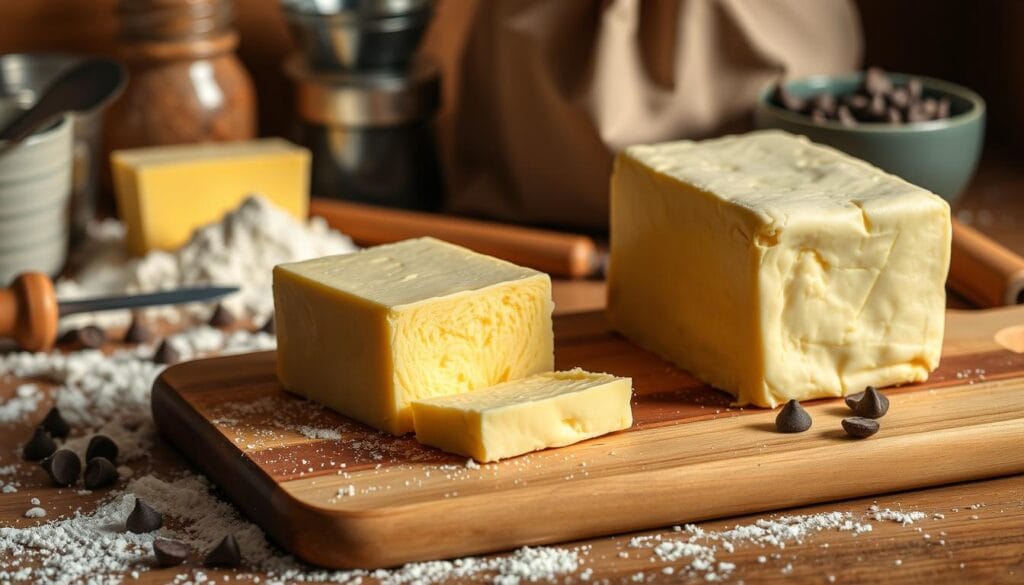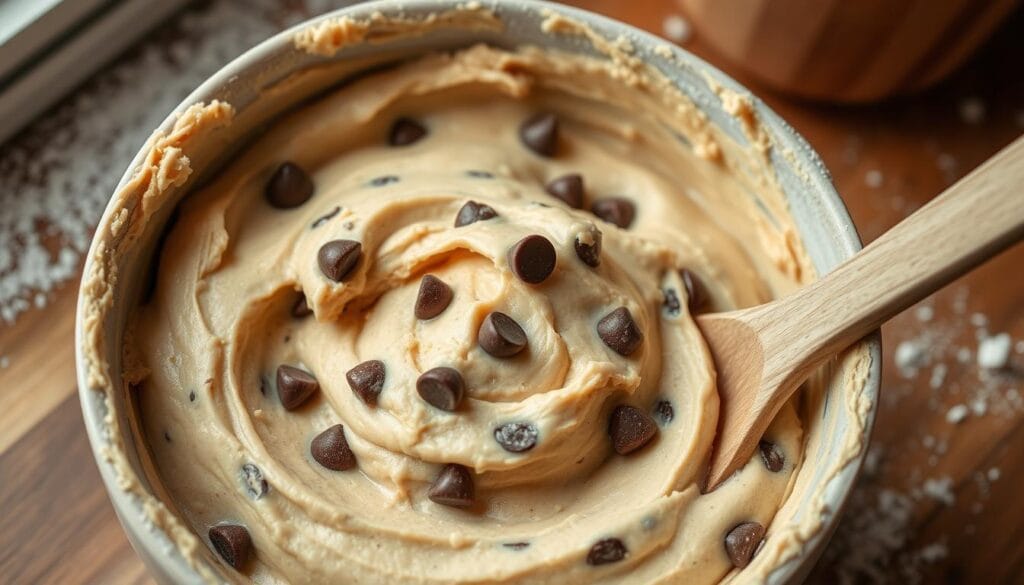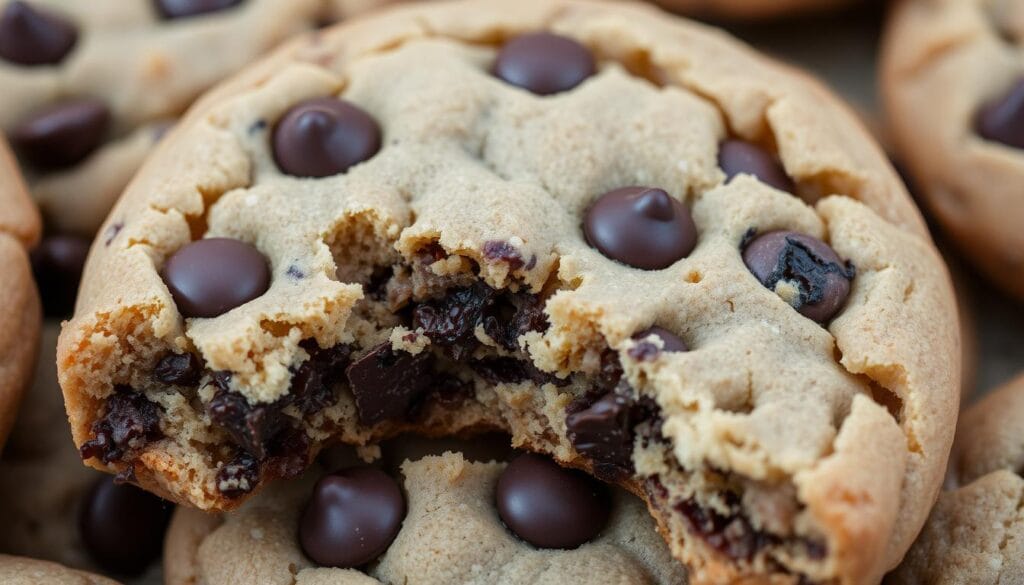I love baking cookies at home. But sometimes, my Ghirardelli chocolate chip cookies turn out flat. If you’ve had this problem too, don’t worry. You’re not alone.
Making perfect Ghirardelli cookies is an art. Knowing the science behind it helps a lot. Things like butter consistency and oven temperature matter a lot. But don’t worry, with some tips, you can make flat-free Ghirardelli cookies that everyone will love.
Understanding the Ingredients in Ghirardelli Cookies
To make the perfect Ghirardelli cookie, knowing each ingredient’s role is key. The quality of butter and sugar types is crucial. They all affect the cookie’s texture and shape.
The Role of Butter in Cookie Texture
Butter is the base of Ghirardelli cookies. Its softness greatly affects the cookie’s texture. Using butter at room temperature is best. It mixes well with sugars, making the cookie light and tender.
Butter that’s too soft or melted can make cookies spread too much. This results in a cookie that’s flat and greasy.
How Sugar Affects Cookie Shape
Sugar types also shape the cookie. Granulated sugar makes cookies spread and become thinner and crisper. Brown sugar, on the other hand, keeps cookies chewy and thicker. If you’re wondering why are my Ghirardelli cookies flat, sugar might be a factor to consider.
Finding the right mix of these sugars is important. It helps get the perfect texture for Ghirardelli cookies.
Also, the right amounts of flour, baking soda, and butter are crucial. They help prevent cookies from spreading too much. This ensures they keep their shape and texture.
| Ingredient | Quantity | Purpose |
|---|---|---|
| All-purpose flour | 2 cups | Provides structure and prevents excessive spreading |
| Salt | 1 teaspoon | Enhances and balances the sweetness |
| Baking soda | 3/4 teaspoon | Helps the cookies rise and maintain their shape |
| Unsalted butter | 1 cup (2 sticks) | Contributes to the rich, tender texture |
| Light brown sugar | 2/3 cup | Adds chewiness and a caramelized flavor |
| Granulated sugar | 2/3 cup | Promotes spreading and a crispy edge |
| Large egg + 1 egg yolk | 1 + 1 | Provides structure and moisture |
| Pure vanilla extract | 2 teaspoons | Enhances the overall flavor |
| Chocolate chips | 1 bag | Adds delicious chocolate flavor and texture |

The Impact of Baking Soda and Baking Powder
Leavening agents like baking soda and baking powder are key for perfect cookies. They help your cookies rise and spread. Knowing how they work can make a big difference.
Differences Between Baking Soda and Baking Powder
Baking soda needs acidic ingredients like chocolate or buttermilk to work. It makes carbon dioxide bubbles that make the dough rise. Baking powder, however, has both acid and base. It works without extra acidic ingredients.
The Right Amount for Perfect Cookies
Using the right amount of baking soda or baking powder is very important. Too little makes cookies flat and dense. Too much can make them spread too much and taste bad. The right amount depends on the recipe, so always follow the instructions.
By learning about leavening agents and finding the right mix, you can make tasty, well-risen cookies every time.

Mixing Your Cookie Dough Correctly
Mixing your cookie dough right is key to making perfect Ghirardelli cookies. It helps get the dough just right and stops cookies from getting flat. Let’s explore why mixing is important and how to avoid mistakes.
How Overmixing Can Flatten Cookies
Overmixing can make your cookies flat and dense. It builds up too much gluten, making the cookies tough. Mix the ingredients just until they’re combined, without overdoing it.
The Importance of Creaming Ingredients
Creaming butter and sugar is a crucial step in baking cookies. It adds air to the dough, making your cookies soft and chewy. Take your time to make the mixture light and fluffy.
Getting the mix just right is the secret to perfect cookies. Don’t overmix, but make sure everything is well combined and airy for the best results.

The Role of Eggs in Cookie Recipes
Eggs are key in cookie recipes. They help with the cookie’s structure and texture. They also make the cookies moist and consistent.
Why Eggs Are Essential for Structure
Eggs have proteins that give cookies shape and stability. They mix wet and dry ingredients well. Without eggs, cookies might be crumbly and weak.
Temperature of Eggs: Room Temperature vs. Cold
The egg’s temperature affects the cookie texture. Room-temperature eggs mix better, making the dough smooth. Cold eggs can make the dough stiff, leading to uneven cookies.
Getting the right number of eggs is important. Too many can make cookies too moist. Too few can make them dry. The right egg amount and temperature are key for perfect Ghirardelli cookies.
| Issue | Percentage of Recipe Adjustments |
|---|---|
| Flour-related problems | 31% |
| Butter-related problems | 12% |
| Egg-related issues | 9% |
Knowing how eggs work in cookies helps make perfect Ghirardelli cookies. Use them at the right temperature for the best results.

Chilling Your Dough: Is It Necessary?
As any avid baker knows, the secret to achieving the perfect Ghirardelli cookie lies not just in the quality of the ingredients, but also in the preparation process. Chilling the cookie dough before baking is a crucial step. But is it necessary, and how long should you chill your dough?
Benefits of Chilling Cookie Dough
Chilling the cookie dough is a crucial step that helps prevent excessive cookie spread during baking. If you’re wondering why are my Ghirardelli cookies flat, skipping this step might be the reason. As the fats in the dough solidify while chilling, they become more resistant to spreading. This results in cookies that hold their shape better.
Additionally, the chilling process allows the flavors in the dough to develop more fully. This leads to richer, more complex taste profiles.
How Long Should I Chill My Dough?
- For the best baking preparation, Ghirardelli cookie recipes typically recommend chilling the dough for at least 1-2 hours before baking.
- However, the optimal chilling time can vary depending on the recipe. Some recipes may benefit from an overnight chill, which allows the flavors to truly meld and develop.
- As a general rule, the longer you chill the dough, the chewier and more flavorful the cookies will be. But even a 30-minute chill can help prevent excessive cookie dough chilling.
So, if you want to enjoy perfectly shaped, deliciously rich Ghirardelli cookies, be sure to give your dough the time it needs to chill before baking. Your patience will be rewarded with cookies that are worth the wait!
Oven Temperature and Its Effects on Baking
Baking Ghirardelli cookies needs the right oven temperature. This ensures they turn out just right. The perfect temperature helps them bake evenly, so they don’t end up flat.
Preheating: Why It Matters
Preheating your oven is key for even heat. It helps your cookies rise and keep their shape. Without preheating, cookies might cook unevenly. Some parts could be too soft, while others get too dark.
The Best Temperature for Ghirardelli Cookies
The best temperature for Ghirardelli cookies is 375°F (190°C). This temperature is just right. It lets the cookies spread a bit and get a golden brown outside. Inside, they stay soft and chewy.
Always check your oven’s temperature with an oven thermometer. This ensures it’s accurate. A small mistake here can affect your cookies a lot.
Focus on the oven temperature and preheating. This will help you bake perfect Ghirardelli cookies every time.
The Influence of Baking Sheets and Parchment Paper
Baking the perfect Ghirardelli cookies depends on your baking equipment. The baking sheet is key for cookie spread and browning.
Choosing the Right Baking Sheet
Choose a light-colored, heavy-gauge aluminum baking sheet for even baking. These sheets spread heat well, preventing burning or uneven browning. Dark or non-stick sheets can make cookies spread too much and bake unevenly.
Importance of Parchment Paper
Parchment paper is essential for Ghirardelli cookies. It prevents cookies from sticking and promotes even browning. It also stops cookies from spreading too much.
Don’t grease your baking sheets too much. This can make cookies spread too much. Let parchment paper keep cookies in shape.
Let baking sheets cool completely between batches. This stops the dough from spreading too soon. With the right equipment and parchment paper, your Ghirardelli cookies will always be perfect.
Cookie Size and Spacing on the Baking Sheet
Baking the perfect Ghirardelli cookies depends on the dough size and spacing. The cookie size affects baking time and texture.
How Size Affects Baking
Even-sized cookie dough ensures all cookies bake the same. A cookie scoop makes portions uniform. This prevents some cookies from being too thin or underbaked.
Proper Spacing for Optimal Results
Place cookie dough balls 2 inches apart on the baking sheet. This lets cookies spread without merging. Proper spacing also ensures even heat, keeping cookies shaped right.
| Baking Tip | Benefit |
|---|---|
| Use a cookie scoop for uniform portions | Ensures even baking and consistent texture |
| Space cookies at least 2 inches apart | Allows for proper spreading and even heat distribution |
The Impact of Altitude on Baking Cookies
Baking at high altitudes can be tough for cookie lovers. The lower air pressure changes how your cookies turn out. Knowing how altitude affects baking helps you adjust your recipes for the best results.
Baking at High Altitudes: What Changes?
At high elevations, cookies bake faster and spread more. This makes them flat and thin instead of soft and round. The lower air pressure changes how leavening agents work in the dough.
Adjusting Ingredients for Altitude
To fix high-altitude baking, you need to tweak your Ghirardelli cookie recipe. If you’re wondering why are my Ghirardelli cookies flat, altitude adjustments might be the solution. Add 1-2 tablespoons of flour for each cup to help cookies hold their shape and not spread too much.
Also, cut down sugar and leavening agents by 1/4 to 1/2 teaspoon. Finally, increase the oven temperature by 25°F to 50°F. This helps cookies set faster.
Keep in mind that the right adjustments depend on your elevation. Start with small batches and make small changes. Soon, you’ll bake perfect cookies at high altitudes.
Troubleshooting Flat Cookie Issues
Getting the perfect, soft Ghirardelli chocolate chip cookies is tricky. If your cookies are flat, don’t worry. I’ve got some tips to help. We’ll look at common mistakes and how to fix them.
Common Mistakes and Solutions
Too little flour can make cookies flat. Try adding a tablespoon or two of flour. Also, don’t grease the baking sheets too much. Use parchment paper instead to keep the cookies from spreading.
Butter’s consistency is key. Soft or melted butter can make cookies greasy. Use butter that’s room temperature but still a bit firm. Chilling the dough for 30 minutes helps too.
Signs That Point to a Problem
Watch for signs like cookies spreading too much. This means the dough is too soft or the sheets are greasy. If cookies are crisp and greasy, the butter is too warm or the dough isn’t chilled.
By avoiding these mistakes and using the right fixes, you’ll make perfect cookies. Try the Ghirardelli chocolate chip cookies recipe for the best results. Happy baking!
Final Tips for Perfect Ghirardelli Cookies
Wrapping Up with Best Practices
Let’s talk about making the perfect Ghirardelli cookies. First, measuring ingredients accurately is key. Using room-temperature ingredients and chilling them helps a lot. If you’re wondering why are my Ghirardelli cookies flat, this step can make a big difference in maintaining their shape.
Also, baking them a bit under and cooling them on the sheet makes them chewy. But, baking a bit longer and cooling on a wire rack makes them crispy. Always choose the best ingredients, like Ghirardelli chocolate chips, for great taste.
My Favorite Variations and Add-Ins
While classic Ghirardelli cookies are amazing, you can try new things. Swap some semi-sweet chips for milk or white chocolate chips.
Adding nuts like toasted pecans or walnuts can also make them better. For more flavor, add a little cinnamon or nutmeg. You can make these cookies your own with endless variations.
FAQ
Why are my Ghirardelli cookies flat?
Flat cookies can come from soft butter, wrong ingredient amounts, and baking errors. Too soft or melted butter, not enough flour, overmixing, and wrong oven temperature are common problems. It’s important to measure ingredients right, prepare the dough well, and bake correctly to get the right cookie texture and shape.
How does the butter consistency affect cookie texture?
The butter’s temperature greatly affects the cookie texture. Room-temperature butter is best. Different sugars change cookie shape and texture. Granulated sugar makes cookies spread more, while brown sugar makes them chewier. The right mix of ingredients is key to the cookie’s consistency and preventing too much spreading.
What is the role of baking soda and baking powder in cookies?
Baking soda and baking powder help cookies rise and spread. Baking soda works with acidic ingredients while baking powder has both acid and base. Using the right amount of these agents is critical; too little makes cookies flat, and too much causes them to spread too much and taste bitter.

